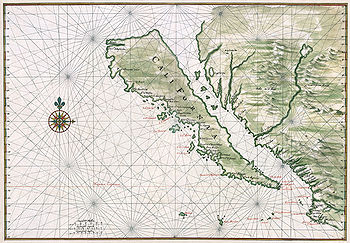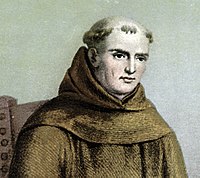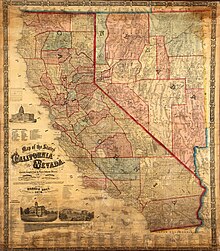History of California before 1900
The remains of Arlington Springs Man on Santa Rosa Island are among the traces of a very early habitation, dated to the Wisconsin glaciation (the most recent ice age) about 13,000 years ago.These groups included the early-arriving Hokan family (winding up in the mountainous far north and the Colorado River basin in the south) and the later-arriving Uto-Aztecan of the desert southeast.At the time of the first European contact, Native American tribes in California included the Chumash, Kumeyaay, Nisenan, Maidu, Miwok, Modoc, Mohave, Ohlone, Pomo, Serrano, Shasta, Tataviam, Tongva, Wintu, Yurok, and Yokuts.[4] A dietary staple for most indigenous populations in interior California was acorns, which were dried, shelled, ground to flour, soaked in water to leach out their tannin, and cooked.[21] Cabrillo died as the result of an accident during this voyage; the remainder of the expedition, which may have reached as far north as the Rogue River in today's southern Oregon, was led by Bartolomé Ferrer.These galleons, after crossing most of the Pacific Ocean, would arrive off the California coast 60 to over 120 days later, near Cape Mendocino, about 300 miles (480 km) north of San Francisco, at about 40 degrees N. latitude.His major contributions to the state's history were the glowing reports of the Monterey area as an anchorage and as land suitable for settlement and growing crops, as well as the detailed charts he made of the coastal waters (which were used for nearly 200 years).Settlements in Loreto, Baja California Sur, were established in 1697, but it was not until the threat of incursion by Russian fur traders and potentially settlers, coming down from Alaska in 1765, that Spain, under King Charles III, felt development of more northern installations was necessary.Eager to press on to Monterey Bay, de Portolá and his group, consisting of Father Juan Crespí, 63 leather-jacket soldiers and a hundred mules, headed north on July 14.The California missions comprise a series of religious outposts established by Spanish Catholic Dominicans, Jesuits, and Franciscans, to spread the Christian doctrine among the local Native Americans.[40] Most missions became enormous in terms of land area (approximately the size of modern counties in California), and yet the Spanish and Mexican staff was small, with normally two Franciscans and six to eight soldiers in residence.In 1810, the California missions and presidios lost their financing as the Spanish Empire collapsed from Buenos Aires to San Francisco, as a result of the imprisonment of King Fernando VII in 1808 by the French.[42][43] Heavy freight movement over long distances was practical only via water, but soldiers, settlers and other travelers and merchandise on horses, mules, or carretas (ox carts), and herds of animals used these routes.Due to the growth of the Hispanic population in Alta California by 1804, the province of Las Californias, then a part of the Commandancy General of the Internal Provinces, was divided into two separate territorial administrations following Palóu's division between the Dominican and Franciscan missions, which was defined as the latitude of the large cross on a large rock immediately north of the Misión San Miguel Arcángel de la Frontera that was set up as Palóu's boundary marker.In the early 19th century, fur trappers with the Russian-American Company of Imperial Russia explored down the West Coast from trading settlements in Alaska, hunting for sea otter pelts as far south as San Diego.In August 1812, the Russian-American Company set up a fortified trading post at Fort Ross, near present-day Bodega Bay on the Sonoma Coast of Northern California, 60 miles (97 km) north of San Francisco on land claimed, but not occupied, by the British Empire.Independent Mexico came into existence in 1821, yet did not send a governor to California until 1825, during the First Mexican Republic, when José María de Echeandía brought the spirit of republican government and mestizo liberation to the frontier.Senior members of Alta California's legislature Juan Bautista Alvarado and José Castro, with support from Mariano Guadalupe Vallejo, Comandante of the Fourth Military District and Director of Colonization of the Northern Frontier, and assistance from a group of Americans led by Isaac Graham, staged a revolt in November 1836 and forced Gutierrez to relinquish power.In 1840, Graham allegedly began agitating for a Texas-style revolution in California, in March issuing a notice for a planned horse race that was loosely construed into being a plot for revolt.In October, before Micheltorena reached Monterey, American Commodore Thomas ap Catesby Jones mistakenly thought that war had broken out between the United States and Mexico.Upon hearing rumors of war, U.S. consul Thomas O. Larkin, stationed in Monterey, tried to keep peace between the Americans and the small Mexican military garrison commanded by José Castro.American army captain John C. Frémont, with about 60 well-armed men, had entered California in December 1845 and was making a slow march to Oregon when they received word that war between Mexico and the U.S. was imminent.Frémont's "California Battalion" swelled to about 160 men with the addition of volunteers recruited from American settlements, and on July 19 he entered Monterey in a joint operation with some of Stockton's sailors and marines.The U.S. naval forces (which included U.S. Marines) easily took over the north of California; within days, they controlled Monterey, Yerba Buena, Sonoma, San Jose, and Sutter's Fort.Two hundred reinforcements were sent by Stockton, led by US Navy Captain William Mervine, but were repulsed in the Battle of Dominguez Rancho, October 7–9, 1846, near San Pedro, where 14 U.S. Marines were killed.Between 1849 and 1870 it is estimated that American colonists murdered some 9,500 California Natives, and acts of enslavement, kidnapping, rape, child separation and displacement were widespread, encouraged, carried out by and tolerated by state authorities and militias.Some Native American tribes fought back, beginning with the Ahwahnechees and the Chowchilla in the Sierra Nevada and San Joaquin Valley leading a raid on the Fresno River post of James D. Savage, in December 1850.In retaliation Mariposa County Sheriff James Burney led local militia in an indecisive clash with the natives on January 11, 1851, on a mountainside near present-day Oakhurst, California.Printers first attempted to organize in 1850, teamsters, draymen, lightermen, riggers and stevedores in 1851, bakers and bricklayers in 1852, caulkers, carpenters, plasterers, brickmasons, blacksmiths and shipwrights in 1853 and musicians in 1856.[76] The establishment of America's transcontinental rail lines permanently linked California to the rest of the country, and the far-reaching transportation systems that grew out of them during the century that followed contributed immeasurably to the state's unrivaled social, political, and economic development.







History of California (1900–present)History of CaliforniaProvince of Las CaliforniasAlta CaliforniaCalifornia RepublicConquest of CaliforniaInterim governmentsCalifornia Gold RushSince 1900MaritimeNewspapersRailroadsHighwaysSlaveryEugenicsAnaheimFresnoLos AngelesOaklandPasadenaPiedmontRiversideSacramentoSan BernardinoSan DiegoSan FranciscoSan JoseSanta BarbaraSanta MonicaVisaliaBay AreaSan Fernando ValleySanta Catalina IslandYosemiteBibliography of California historyBibliography of Los AngelesHuman historyCaliforniaindigenous AmericansEuropean settlementNew SpainMexicoMexican–American WarTreaty of Guadalupe HidalgoU.S. westward expansionfree stateCompromise of 1850agriculturalIndigenous peoples of Californiamodel of migration to the New WorldBering land bridgeAmericasArlington Springs ManSanta Rosa IslandWisconsin glaciationmost recent ice agetribeslanguage familyColorado RiverUto-AztecanNative AmericanChumashKumeyaayNisenanMohaveOhloneSerranoShastaTataviamTongvaYokutspopulation of Native CaliforniaAuckland MuseumclimatesmusselCentral ValleysalmonobsidianSanta Barbara, CaliforniaChannel Islandslarge plank canoesSan Francisco Bay AreadugoutacornstanninMediterranean climateforest gardeningNative Americans controlled firefire ecologysustained a low-density "wild" agriculturefire-stick farmingpermacultureSierra NevadaGreat Basin DesertSonoran DesertMojave DesertYuman language speakingColoradoGila RiversBaja CaliforniaSonoraAthabaskan language speakingindigenous peoples along the Coast of the Pacific NorthwestPolynesianNative HawaiiansislandEnglandPacific OceanRussianBritishHernán CortésNuño Beltrán de GuzmánSeven Cities of CibolaAmazonish womenLa PazBaja California peninsulaFrancisco de UlloaIsland of CaliforniaCedros IslandHernando de AlarcónGerardus MercatorAbraham Orteliusname "California"Garci Rodríguez de MontalvoJuan Rodríguez CabrilloPortuguese